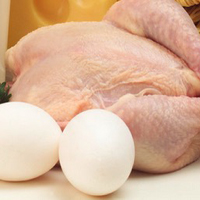Incidence of ionophore and non-ionophore anticoccidials residues in poultry meat and eggs and their risk characterization

Accepted: 18 December 2020
HTML: 6
All claims expressed in this article are solely those of the authors and do not necessarily represent those of their affiliated organizations, or those of the publisher, the editors and the reviewers. Any product that may be evaluated in this article or claim that may be made by its manufacturer is not guaranteed or endorsed by the publisher.
Authors
A multi-residue method was applied to investigate the incidence and the concentration of ionophores and non-ionophore anticoccidials residues in poultry meat and hen eggs for the three-year period 2017-2019 in Italy. The risk related to the ingestion of such molecules was also characterized for the entire population. The average incidences of positive samples ranged from 1.35 to 9.45% while the maximum average concentration was of 4.28 μg/kg for nonionophore molecules. No uncompliant sample was recorded. The overall risk characterization related to the intake of anticoccidials trought chicken meat and eggs reveal a minor concern for consumers of all age. However, the monitoring of coccidiostates residues through official control activity in poultry meat and egg is crucial and it should be continuously conducted to ensure safety of such products and safeguard consumers̛ health.
Bacila DM, Feddern V, Mafra LI, Scheuermann GN, Molognoni L, Daguer H, 2017. Current research, regulation, risk, analytical methods and monitoring results for nicarbazin in chicken meat: A perspective review. Food Res Int 99:31-40.
Branciari R, Roila R, Ranucci D, Altissimi MS, Mercuri ML, Haouet NM, 2020. Estimation of acrylamide exposure in Italian schoolchildren consuming a canteen menu: health concern in three age groups. Int J Food Sci Nut, 71:122-131.
Chapman HD, 2009. A landmark contribution to poultry science—prophylactic control of coccidiosis in poultry. Poult Sci 88: 813-815.
Chapman HD, 2014. Milestones in avian coccidiosis research: A review. Poult Sci 93:501–511.
Clarke L, Fodey TL, Crooks SR, Moloney M, O'Mahony J, Delahaut P, O'Kennedy R, Danaher M, 2014. A review of coccidiostats and the analysis of their residues in meat and other food. Meat Sci 97: 358-374.
Danaher M, Campbell K, O’Keeffe M, Capurro E, Kennedy G, Elliott CT, 2008. Survey of the anticoccidial feed additive nicarbazin (as dinitrocarbanilide residues) in poultry and eggs. Food Addit Contam 25:32-40.
Dorne JLCM, Fernández-Cruz ML, Bertelsen U, Renshaw DW, Peltonen K, Anadon A, Feil A, Sanders P, Wester P, Fink-Gremmels J, 2013. Risk assessment of coccidostatics during feed cross-contamination: animal and human health aspects. Toxicol Applied Pharm, 270:196-208.
European Commission 2002. Commission Decision (EC) No 657/2002 of 12 August 2002 implementing CouncilDirective 96/23/EC concerning the performance of analytical methods and the interpretation of results. In: Official Journal, L221/8, 17/8/2002.
European Commission 2009. Commission Regulation (EC) No 152/2009 of 27 January 2009 laying down the methods of sampling and analysis for the official control of feed. In: Official Journal, L54/1, 26/2/2009.
European Commission 2013. Commission Regulation (EC) No 691/2013 of 19 July 2013 amending Regulation (EC) No 152/2009 as regards methods of sampling and analysis. In: Official Journal, L197/1, 20/7/2013.
European Food Safety Authority 2010a. Management of left-censored data in dietary exposure assessment of chemical substances. EFSA J 8:1557.
European Food Safety Authority 2010b. Scientific Opinion on the safety and efficacy of Koffogran (nicarbazin) as a feed additive for chickens for fattening. EFSA J 8:155.
European Food Safety Authority 2020a. Report for 2018 on the results from the monitoring of veterinary medicinal product residues and other substances in live animals and animal products. EFSA Supporting Publications, 17: 1775.
European Food Safety Authority 2020b. The Comprehensive Food Consumption Database. https://www.efsa.europa.eu/en/food-consumption/comprehensive-database. Accessed on 30.07.2020.
European Parliament 2003. Regulation (EC) No 1831/2003 Of The European Parliament and Of The Council of 22 September 2003 on additives for use in animal nutrition. In: Official Journal, L268/29, 18/10/2003.
ISO/IEC 2017. General Requirements for the Competence of Testing and Calibration Laboratories. ISO Norm 17025:2017. International Standardization Organization ed., Geneva, Switzerland.
Kabak B, 2016. Aflatoxins in hazelnuts and dried figs: Occurrence and exposure assessment. Food Chem 211:8-16.
Kennedy DG, Hughes PJ, Blanchflower WJ, 1998. Ionophore residues in eggs in Northern Ireland: incidence and cause. Food Addit Contam, 15:535-541.
McEvoy JDG, 2002. Contamination of animal feedingstuffs as a cause of residues in food: A review of regulatory aspects, incidence and control. Anal Chim Acta 473:3-26.
Mortier L, Daeseleire E, Peteghem CV, 2005. Determination of the ionophoric coccidiostats narasin, monensin, lasalocid and salinomycin in eggs by liquid chromatography/tandem mass spectrometry. Rapid Commun Mass Spectrom 19: 533-539.
Moy G, Vannoort R, 2013. Total Diet Studies. Springer, London, UK, pp 169–177.
Olejnik M, Szprengier-Juszkiewicz T, Jedziniak P, 2014. Distribution of semduramicin in hen eggs and tissues after administration of cross-contaminated feed. Food Additiv Contam Part A 31:1393-1398.
Roila R, Branciari R, Staccini B, Ranucci D, Miraglia D, Altissimi MS, Haouet MN, 2018. Contribution of vegetables and cured meat to dietary nitrate and nitrite intake in Italian population: Safe level for cured meat and controversial role of vegetables. Ital J Food Saf 7:7692.
Roila R, Branciari R, Pecorelli I, Cristofani E, Carloni C, Ranucci D, Fioroni L, 2019. Occurrence and Residue Concentration of Coccidiostats in Feed and Food of Animal Origin; Human Exposure Assessment. Foods, 8: 477.
Vincent U, Ezerskis Z, Chedin M, von Holst C, 2011. Determination of ionophore coccidiostats in feeding stuffs by liquid chromatography–tandem mass spectrometry. Part II. Application to cross-contamination levels and non-targeted feed. J Pharmaceut Biomed 54: 526-534.
Williams RB, 1999. A compartmentalised model for the estimation of the cost of coccidiosis to the world's chicken production industry. Int J Parasitol, 29:1209-1229.
World Health Organization 2017. WHO Technical Report Series, No. 1002. Evaluation of certain contaminants in food Eighty-third report of the Joint FAO/WHO Expert Committee on Food Additives.
How to Cite
PAGEPress has chosen to apply the Creative Commons Attribution NonCommercial 4.0 International License (CC BY-NC 4.0) to all manuscripts to be published.

 https://doi.org/10.4081/ijfs.2021.9332
https://doi.org/10.4081/ijfs.2021.9332



